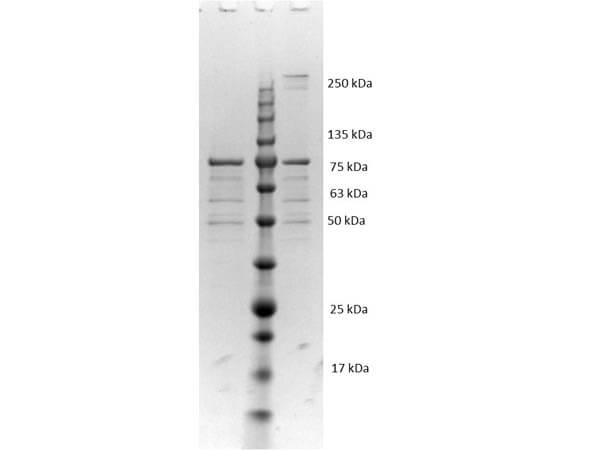Datasheet is currently unavailable. Try again or CONTACT US
Histone H3 (66-80) Biotin Conjugated
000-006-K63
1 mg
Lyophilized
Shipping info:
$50.00 to US & $70.00 to Canada for most products. Final costs are calculated at checkout.
Product Details
Histone H3 Biotin Conjugated Peptide - 000-006-K63
H3.3AH3F3H3F3B, H3.3B, H3 histone, family 3A, histone H3.3, MGC87782, MGC87783, Histone H3 peptide, control peptide, blocking peptide
Biotin
Peptide
Target Details
Greater than 95% specific peptide.
Application Details
Histone H3 Control Peptide is suitable for use in ELISA, Western Blot, Dot blot, PCA, and other assays. Control peptide should be used at 1.0 µg per 1.0 µl of antiserum in per assay. Specific conditions for reactivity should be optimized by the end user.
Formulation
1.0 mg/mL by dry weight
None
1.0 mL
Restore with deionized water (or equivalent)
Shipping & Handling
Ambient
Store vial at 2 - 8 ° C prior to opening. Aliquot contents and freeze at -20° C or below for extended storage. Avoid cycles of freezing and thawing. Centrifuge product if not completely clear after standing at room temperature. Dilute only prior to immediate use.
Expiration date is one (1) year from date of receipt.
The nucleosome is comprised of 146 bp of DNA wrapped around a series of histone proteins arranged as an octamer consisting of 2 copies of histone H2A, H2B, H3 and H4. Within the nucleosome core the histone proteins are covalent modified at specific residues predominantly within the N-terminal tail including lysine (acetylation, methylation, SUMOylation, and ubiquitinylation), arginine methylation and citrullination, serine and threonine phosphorylation, as well as proline isomerization. The lysine side chains can carry up to three methyl groups (mono-, di- and tri- methylated forms) and the arginine side chain can be monomethylated or can be dimethylated as the symmetric or asymmetric forms. The modifications show temporal, disease-specific, and other types of cell-specific regulation and there are specific families of enzymes that regulate the methylation, demethylation, acetylation, deacetylation and other modifications. Research has indicated that whereas the histone mark H3K4Me3 (tri-methyl lysine 4 of histone H3) localizes to gene promoter regions (it is associated with transcriptional activation) other modifications at H3K4 such as monomethyl is present predominantly at enhancer sequences. Specific marks have been shown to be associated with the activation (H3K9Me1, H3K27Me1, and H4K20Me1) or repression (H3K9Me2 and Me3, H3K27Me2 and Me3, and H4K20Me2 and Me3) of genes. Monomethylation of H4 at K20, catalyzed by SET8, is essential to genome replication and stability. Multiple DNA breaks are associated with demethylation at this site, resulting in activation of p53 to avoid mitosis and aberrant chromosomal activity. In mammalian stem cells, Xist expression blocks the formation of H4K20me1, which is one of the first examples of a direct connection between chromatin and stem cell differentiation. Histone H3 are ideal for researchers interested in Chromatin Research, Epigenetics, Chromatin Modifiers, Histones and Modified Histones, and Phospho Specific research.
This product is for research use only and is not intended for therapeutic or diagnostic applications. Please contact a technical service representative for more information. All products of animal origin manufactured by Rockland Immunochemicals are derived from starting materials of North American origin. Collection was performed in United States Department of Agriculture (USDA) inspected facilities and all materials have been inspected and certified to be free of disease and suitable for exportation. All properties listed are typical characteristics and are not specifications. All suggestions and data are offered in good faith but without guarantee as conditions and methods of use of our products are beyond our control. All claims must be made within 30 days following the date of delivery. The prospective user must determine the suitability of our materials before adopting them on a commercial scale. Suggested uses of our products are not recommendations to use our products in violation of any patent or as a license under any patent of Rockland Immunochemicals, Inc. If you require a commercial license to use this material and do not have one, then return this material, unopened to: Rockland Inc., P.O. BOX 5199, Limerick, Pennsylvania, USA.

